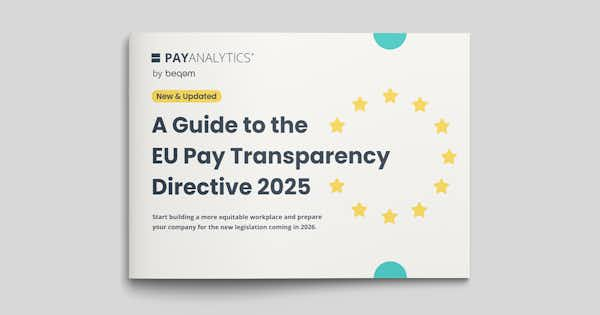A Guide to the EU Pay Transparency Directive 2025 | Download our eGuide for free
Measure

Pay Equity Analysis
Pay equity helps clarify pay structures by identifying drivers of compensation, allowing informed decisions and confident progress.
Overview of all product features
Meet your pay equity goals with the PayAnalytics software. It is designed to get you up and running with minimal setup—supported by video tutorials and digestible documentation.
Pay equity analysis
Reveal the factors influencing pay, make informed decisions.
Pay Transparency
Automate compliance and manage transparency workflows.
Value-based comparison
Compare different jobs under the principle of “equal pay for work of equal value”.
Workforce analytics
Examine and enhance diversity, guide DEI efforts effectively within your organization.
Remediation Actions
Get customized recommendations to close pay gaps, tailored to your needs and budget.
Reports
Essential tools for global compliance and customizable reports for leadership.
Compensation Assistant
Help sustain a bias-free workplace by ensuring good compensation decisions.
Data Management
Refine imported data easily in PayAnalytics with corrections, edits, and additions, ensuring accuracy and visibility.
Job Evaluation
Build objective compensation structures, compare diverse roles based on organizational value.
User Access Controls
Fine-grained access controls, because users have different data access needs.

Are you ready for the EU Pay Transparency Directive? We’ve put together an eGuide to help you learn about the requirements and ensure compliance.
Resources overview
We've put together a knowledge center to help you navigate all things pay equity, DEI, and workforce analytics. This includes articles, downloadable eGuides, podcasts and more.
Guides and E-Books
Explore our how-to guides that give you practical advice on achieving workplace equity. They come in the form of long-form articles and downloadable eGuides.
Articles and blogs
Stay informed on pay equity, transparency, workplace fairness, communication strategies, and current trends.
Local requirements
Stay on top of the changing legal landscape and discover which regulations may apply to you.
The Coffee Talk Podcast
Latest pay equity news in only 8 minutes — every other Friday with Margrét & Henrike.
Customer success stories
Read about how companies have closed the pay gap with PayAnalytics.
Newsletter
Our newsletter covers topics like pay equity, compensation & benefits, DEI, legislation and software updates.

PayAnalytics acquired by beqom
PayAnalytics announced its acquisition by beqom, a leading total compensation and performance management solution provider.
About us
We believe pay is more than a number. Our software is built on over a decade of R&D by award-winning professors, pay equity experts and engineers.
Careers
Join our passionate and highly skilled team. We are pioneers in our field, aiding companies in establishing fair workplaces.
News
The latest company updates, such as events, client news, press releases and so much more.
Brand
Get an overview of our brand, awards, and history. Here you can find downloadable brand assets and photos.
Partnerships
We work with various partners to promote transparency and fairness in pay practices. Explore partnership opportunities.
Consulting services
Tailored pay equity implementation consulting services, designed to complement and enhance the use of our software solutions.
Overview of all product features
Meet your pay equity goals with the PayAnalytics software. It is designed to get you up and running with minimal setup—supported by video tutorials and digestible documentation.
Pay equity analysis
Reveal the factors influencing pay, make informed decisions.
Pay Transparency
Automate compliance and manage transparency workflows.
Value-based comparison
Compare different jobs under the principle of “equal pay for work of equal value”.
Workforce analytics
Examine and enhance diversity, guide DEI efforts effectively within your organization.
Remediation Actions
Get customized recommendations to close pay gaps, tailored to your needs and budget.
Reports
Essential tools for global compliance and customizable reports for leadership.
Compensation Assistant
Help sustain a bias-free workplace by ensuring good compensation decisions.
Data Management
Refine imported data easily in PayAnalytics with corrections, edits, and additions, ensuring accuracy and visibility.
Job Evaluation
Build objective compensation structures, compare diverse roles based on organizational value.
User Access Controls
Fine-grained access controls, because users have different data access needs.
Resources overview
We've put together a knowledge center to help you navigate all things pay equity, DEI, and workforce analytics. This includes articles, downloadable eGuides, podcasts and more.
Guides and E-Books
Explore our how-to guides that give you practical advice on achieving workplace equity. They come in the form of long-form articles and downloadable eGuides.
Articles and blogs
Stay informed on pay equity, transparency, workplace fairness, communication strategies, and current trends.
Local requirements
Stay on top of the changing legal landscape and discover which regulations may apply to you.
The Coffee Talk Podcast
Latest pay equity news in only 8 minutes — every other Friday with Margrét & Henrike.
Customer success stories
Read about how companies have closed the pay gap with PayAnalytics.
Newsletter
Our newsletter covers topics like pay equity, compensation & benefits, DEI, legislation and software updates.
About us
We believe pay is more than a number. Our software is built on over a decade of R&D by award-winning professors, pay equity experts and engineers.
Careers
Join our passionate and highly skilled team. We are pioneers in our field, aiding companies in establishing fair workplaces.
News
The latest company updates, such as events, client news, press releases and so much more.
Brand
Get an overview of our brand, awards, and history. Here you can find downloadable brand assets and photos.
Partnerships
We work with various partners to promote transparency and fairness in pay practices. Explore partnership opportunities.
Consulting services
Tailored pay equity implementation consulting services, designed to complement and enhance the use of our software solutions.
- Home
- Newsroom
Newsroom
Discover PayAnalytics' latest news, events, and press releases. Explore our Resources Overview for comprehensive articles and in-depth material covering pay equity, DEI, and workforce analytics. Stay informed and empowered with our diverse range of content on critical topics in today's workplace landscape.
Sign up for our newsletter
Our newsletter covers topics like pay equity, compensation & benefits, DEI (diversity, equity and inclusion) and legislation changes as well as news on our company and software updates.